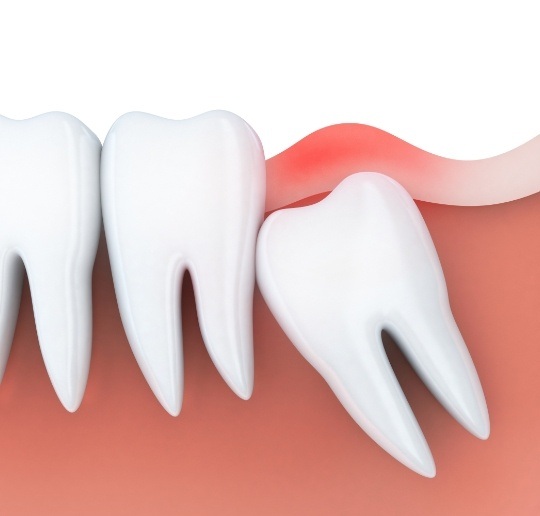Tooth Extractions – Gahanna, OH
Removing Teeth That Put Oral Health at Risk
Tooth extractions are often seen as a last resort for Dr. Odenweller and Dr. Buller. In most cases, they can avoid performing an extraction and recommend more restorative treatments to save your natural tooth. In the event that a tooth becomes so damaged that it needs to be removed, they’ll make sure that you’re feeling comfortable and confident about your tooth extractions in Gahanna, OH. Afterwards, they’ll be more than happy to help you determine which tooth replacement procedure is right for you.
Why Choose Claybrooke Dental of Gahanna for Tooth Extractions?
- Sedation Dentistry Available
- Experienced Team of Dentists
- We Accept Dental Insurance
When is a Tooth Extraction Needed?

In most cases, a tooth is extracted because it has sustained significant decay, particularly decay that has reached well past the enamel and into the inner area of the tooth where the pulp lies. Here, oral bacteria can easily infect the pulp and cause the tooth to die. Keep in mind that an extraction is only performed if it is determine that a root canal cannot sufficiently save the tooth. Furthermore, teeth may need to be extracted if they are causing harm to neighboring teeth or if space needs to be created for orthodontic treatment.
Why Some Tooth Extractions are More Difficult Than Others

The nature of the tooth removal process can vary depending on the circumstances of the tooth. For example, teeth that are visible are much easier to remove because they do not require making additional incisions into gum tissue. If a tooth erupts and it is trapped underneath gum tissue, we need to open that tissue up so that we can safely access the tooth. These key differences are what distinguish simple extractions versus surgical extractions. We’ll make sure to inform you on every step of treatment before we begin.
What Does the Treatment Look Like? The Aftercare?

During a simple extraction, we start by numbing the tooth and the tissue surrounding it to ensure no discomfort is felt during the actual procedure. Then, we gently rock the tooth back and forth using a dental elevator. This breaks the tooth from the periodontal ligament that holds it in place. Next, we’ll use a pair of dental forceps to gently remove the tooth from the jaw. We’ll then ask you to bite down onto a gauze pad so that the socket has a chance to form a clot. This also controls any bleeding. In the case of a surgical extraction, we’ll perform the same steps as a simple extraction, except we’ll create an incision in the gum tissue and potentially break the tooth into smaller pieces to remove them if needed.
After your treatment is complete, you’ll need to:
- Get plenty of rest
- Keep the gauze pad in place for at least two hours before replacing
- Avoid exercise as directed
- Avoid smoking or using a straw for at least three days
- Do not rinse your mouth out or forcefully spit for at least 24 hours
- Keep to a soft diet for 24 hours
- Take pain medication as directed
- Apply an ice pack to your face for 10 minutes at a time, then remove to prevent accidentally damaging your facial tissue. This can be done for up to one hour.
What Solutions are Available to Replace Missing Teeth?

At Claybrooke Dental of Gahanna, there are multiple solutions to replace your missing tooth. These include dental bridges and dental implants. Both of these options are great solutions for replacing teeth and come with their own unique benefits.
Understanding the Cost of Tooth Extractions

Tooth extractions are a last resort, but they can sometimes be necessary to keep your oral health in check. However, even when some patients understand the necessity, the cost of the procedure can give them pause. At Claybrooke Dental of Gahanna, we strive to provide affordable and transparent care. So, read more below to learn how several factors affect the cost of extractions, and how we can help fit your procedure into your budget.
Factors That Can Affect Tooth Extraction Cost

It’s impossible to quote a price for your extraction without a consultation first. This is because the cost of a tooth extraction can depend on several factors, including:
- Type of Extraction: Simple extractions are less expensive than surgical extractions, which may be needed if a tooth is impacted or broken.
- Location of the Tooth: Back teeth, like molars, can be more challenging to remove and may cost more than front teeth.
- Complexity of the Procedure: If you need multiple extractions, or if your tooth is severely damaged or decayed, the time needed to perform the procedure increases, affecting the price.
- Sedation Options: If you’re sensitive to pain or have dental anxiety, sedation options are available but will add to the overall cost.
By considering these factors, our team can provide a tailored treatment plan that fits your unique needs and your budget!
Does Dental Insurance Cover Tooth Extractions?

Most dental insurance plans are likely to cover some of the cost of tooth extractions, especially if they’re deemed medically necessary. However, coverage can vary depending on your plan and the specifics of your procedure.
At Claybrooke Dental of Gahanna, we will work with you to go through your insurance benefits and help you understand your out-of-pocket costs before your procedure. We’ll also file any claims you need for you, so you can focus more on recovery and less on the paperwork.
Other Options for Making Tooth Extractions Affordable

We’re committed to making dental care affordable for all our patients. Whether you have access to dental insurance or not. For those without, we offer an in-house membership plan that provides discounts on a variety of services, including tooth extractions.
Our practice also partners with CareCredit, a third-party financing option that allows you to split the cost of your treatment into manageable monthly payments. Together, these options ensure that you can receive the care you need without breaking the bank.
So, if you’re ready to say goodbye to a bothersome tooth or two, don’t wait! Reach out to us today to schedule your consultation. Soon, we can help you find relief and bring your smile to the next level.
Tooth Extractions FAQs
Does Getting a Tooth Extracted Hurt?
It is very common for patients near you to avoid getting important care because they are afraid it will hurt. Fortunately, whether you are getting one tooth pulled or multiple, the first step is always the same: numbing your mouth.
Some soreness and discomfort are to be expected following an extraction procedure, but following the aftercare instructions closely will not only help mitigate this pain, it will also reduce swelling and promote healing.
Should your pain worsen, or if you begin to exhibit any signs of infection such as a fever, contact Claybrooke Dental of Gahanna right away.
Is There an Alternative to Tooth Extraction?
Although there are many lifelike tooth replacement options like dental implants available, your dentist’s top priority will always be to save your natural teeth.
Whether there are alternatives to having your tooth extracted depends on the reason behind the extraction. If it is due to extensive decay, a root canal may be an option. If it is from periodontal disease, root scaling and planing could help. However, if your dentist recommends extraction, these may not be viable options.
Thus, if your dentist does recommend tooth extraction, rest assured that it is the best way to get your smile strong, healthy, and pain free.
Can I Leave the Space Empty After a Tooth Extraction?
Sometimes, when the tooth being extracted is located toward the back of the mouth, patients think they don’t need to replace it. After all, if nobody can see it, why replace it?
In reality, however, your teeth do so much more than just create a beautiful smile. They are essential to chewing and speaking, too. Even missing just one back tooth can lead to difficulties chewing, which could cause malnutrition and indigestion. Because you need your tongue to make distinct movements against the backs of your teeth to form words, missing front teeth can also cause a lisp.
Therefore, it is recommended that if you need to have a tooth extracted, you should replace it after healing is complete. Your dentist near you can help find a replacement option that suits your budget and needs.
What Risks Are Involved with Tooth Extractions?
Fortunately, tooth extractions are considered extremely safe, but as with any dental procedure, there are some risks involved. The primary risk for tooth extractions is infection, which if not treated swiftly can travel throughout the body.
Another risk is a condition called dry socket, which can be painful and can even delay the healing process significantly.
To prevent this, your dentist will provide you with a list of aftercare instructions, as well as some common symptoms of infection to be aware of as you heal.
I Need a Checkup & Cleaning I Have a Cavity or Broken Tooth I Want to Enhance My Smile I am Missing One or More Teeth I Need a Dentist for My Child I am in Pain & Need Help I am Worried About Bleeding Gums I am Nervous/Afraid of the Dentist I am Concerned about Sleep Apnea View Our Services
